
How to Use 2.0 inch TFT LCD display: Examples, Pinouts, and Specs
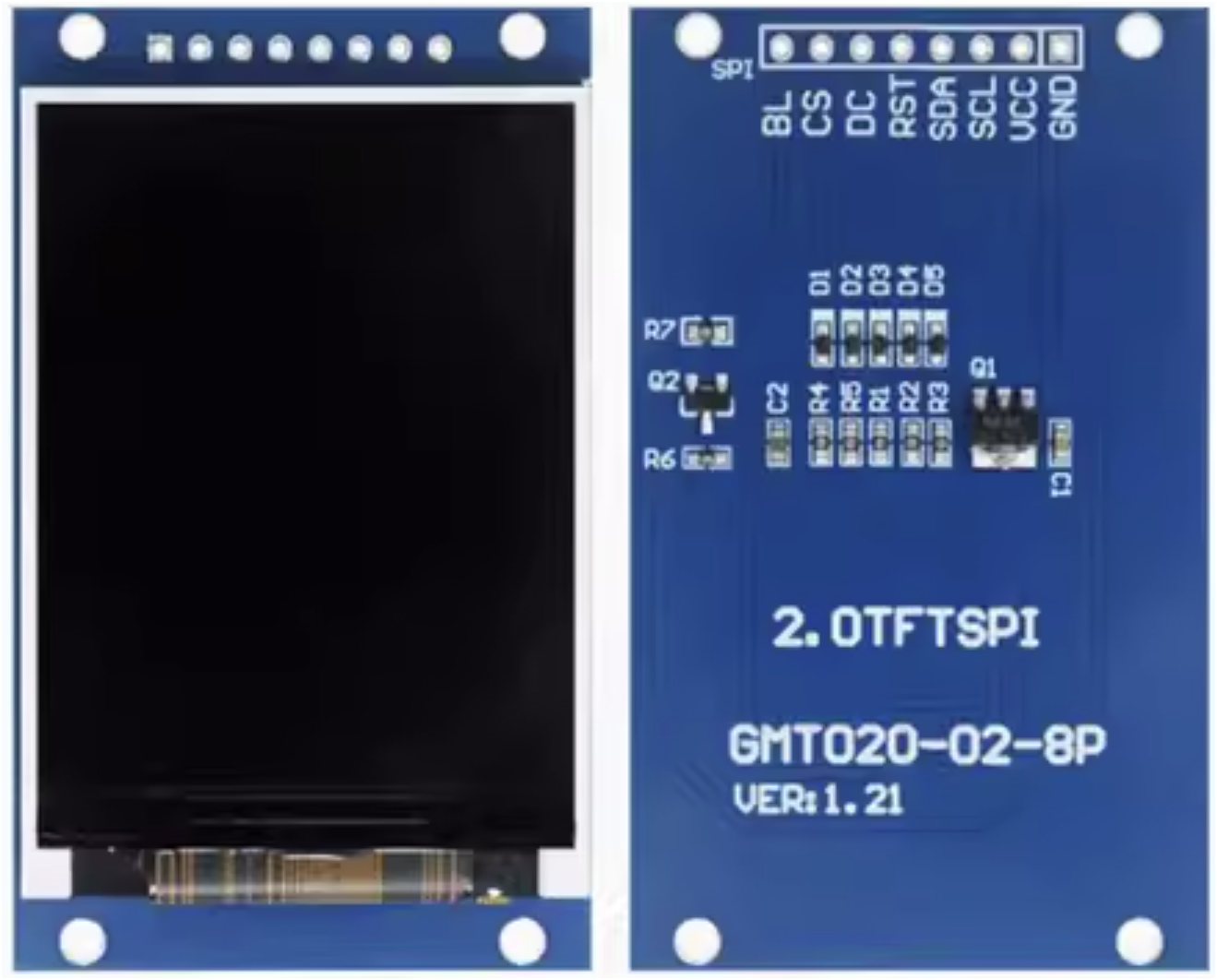
 Design with 2.0 inch TFT LCD display in Cirkit Designer
Design with 2.0 inch TFT LCD display in Cirkit DesignerIntroduction
The 2.0 inch TFT LCD Display (Manufacturer: 1.21 GMT 020-02-8P, Part ID: ST7789) is a compact, high-resolution Thin-Film Transistor Liquid Crystal Display. It is designed to provide vibrant and colorful graphical output, making it ideal for applications requiring a small yet visually appealing display. This display is commonly used in embedded systems, IoT devices, handheld gadgets, and user interface panels.
Explore Projects Built with 2.0 inch TFT LCD display
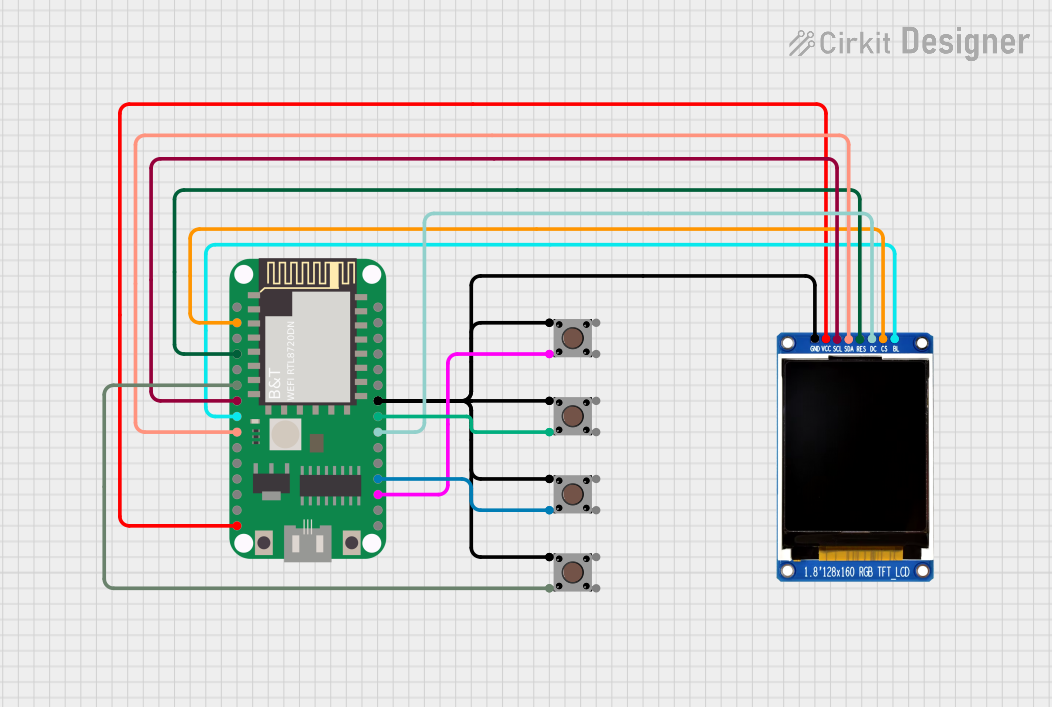
 Open Project in Cirkit Designer
Open Project in Cirkit Designer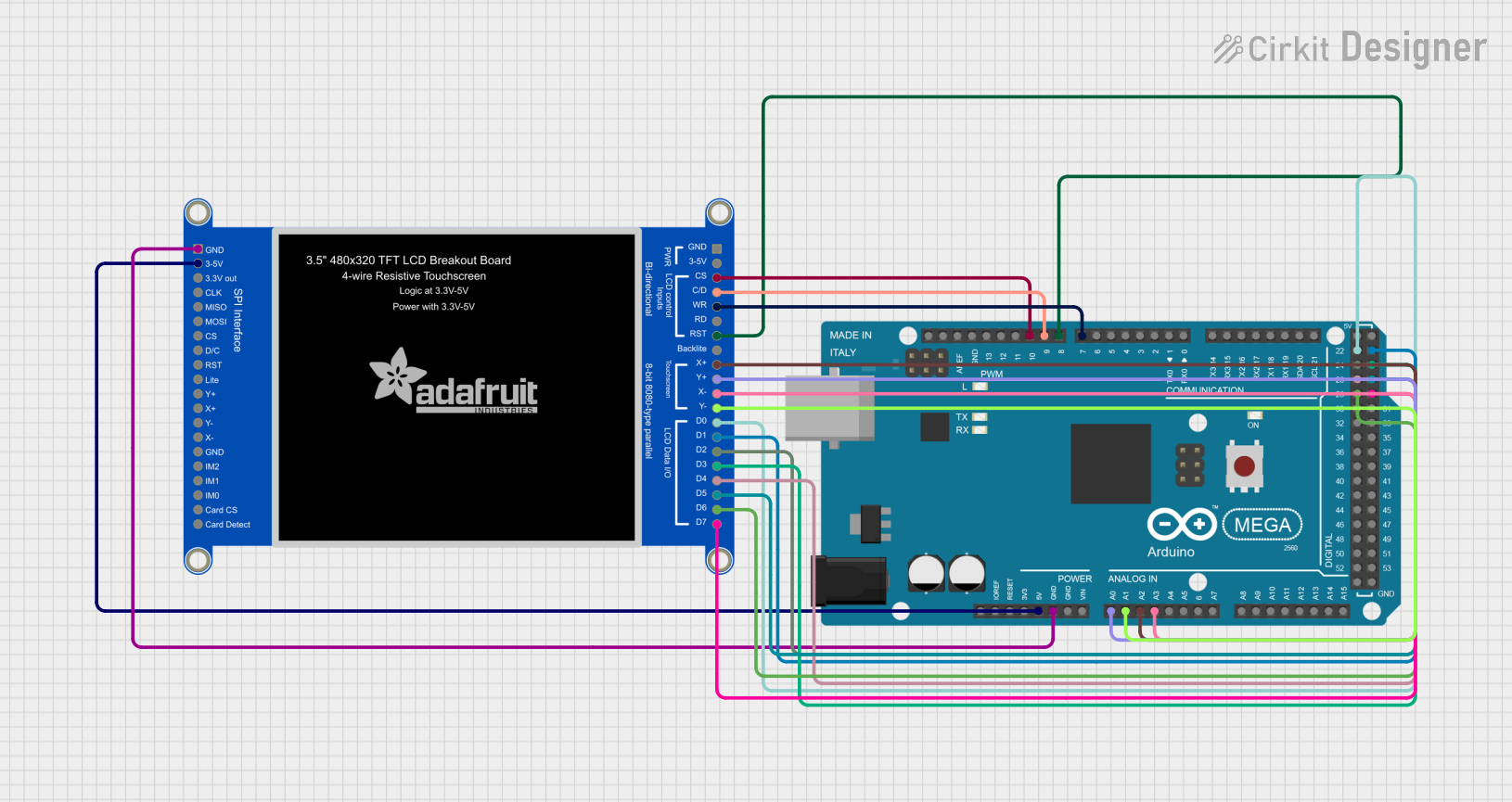
 Open Project in Cirkit Designer
Open Project in Cirkit Designer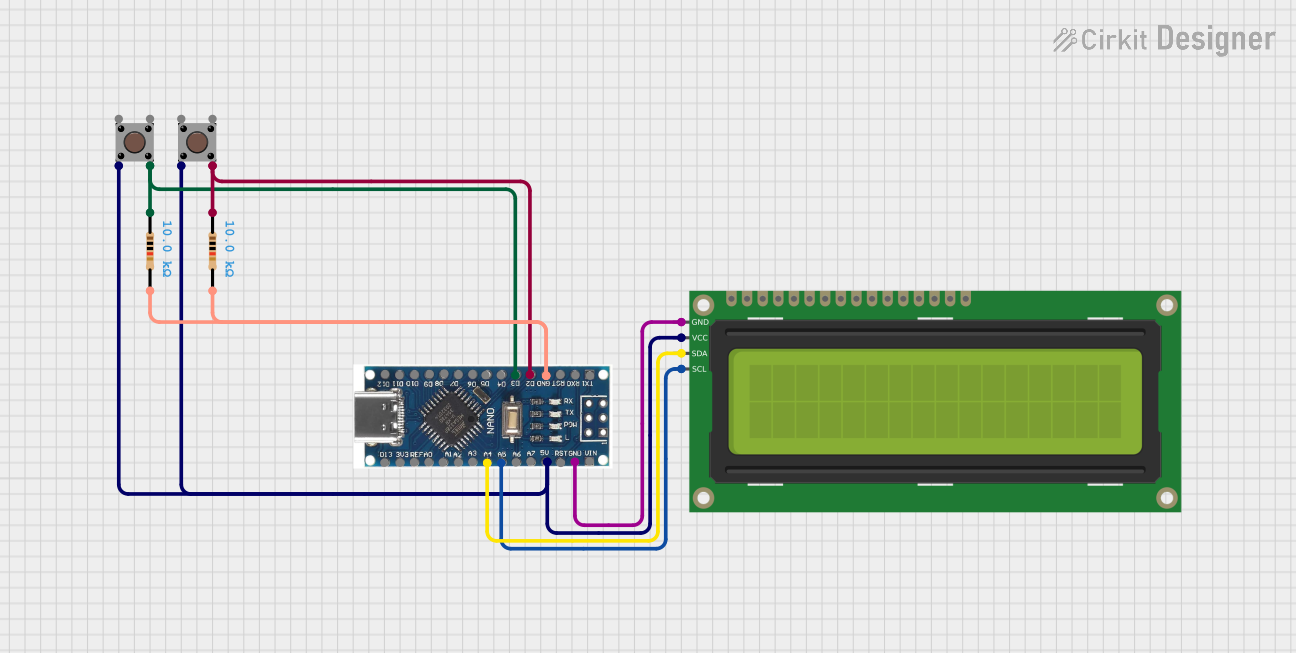
 Open Project in Cirkit Designer
Open Project in Cirkit Designer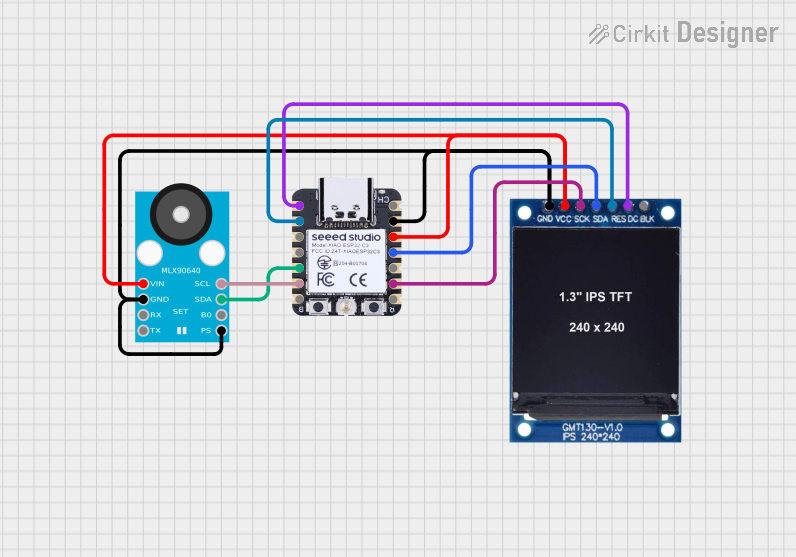
 Open Project in Cirkit Designer
Open Project in Cirkit DesignerExplore Projects Built with 2.0 inch TFT LCD display

 Open Project in Cirkit Designer
Open Project in Cirkit Designer
 Open Project in Cirkit Designer
Open Project in Cirkit Designer
 Open Project in Cirkit Designer
Open Project in Cirkit Designer
 Open Project in Cirkit Designer
Open Project in Cirkit DesignerCommon Applications:
- Graphical user interfaces for embedded systems
- IoT devices with visual feedback
- Portable medical devices
- Wearable electronics
- Small gaming consoles and multimedia players
Technical Specifications
Below are the key technical details of the 2.0 inch TFT LCD Display:
| Parameter | Specification |
|---|---|
| Display Type | TFT LCD |
| Screen Size | 2.0 inches |
| Resolution | 240 x 320 pixels |
| Controller IC | ST7789 |
| Interface | SPI (Serial Peripheral Interface) |
| Operating Voltage | 3.3V |
| Backlight Voltage | 3.0V to 3.3V |
| Current Consumption | ~20mA (typical, with backlight on) |
| Viewing Angle | 160° |
| Color Depth | 65K (16-bit RGB) |
| Operating Temperature | -20°C to 70°C |
| Dimensions (L x W x H) | 42.72mm x 60.26mm x 2.3mm |
Pin Configuration
The display has an 8-pin interface. Below is the pinout and description:
| Pin Number | Pin Name | Description |
|---|---|---|
| 1 | GND | Ground (0V reference) |
| 2 | VCC | Power supply (3.3V) |
| 3 | SCL | Serial Clock (SPI clock input) |
| 4 | SDA | Serial Data (SPI data input) |
| 5 | RES | Reset (Active Low) |
| 6 | DC | Data/Command control (High for data, Low for command) |
| 7 | CS | Chip Select (Active Low) |
| 8 | BLK | Backlight control (PWM or ON/OFF) |
Usage Instructions
Connecting the Display to a Circuit
To use the 2.0 inch TFT LCD Display, connect it to a microcontroller (e.g., Arduino UNO) via the SPI interface. Below is a typical wiring guide for connecting the display to an Arduino UNO:
| TFT Pin | Arduino Pin |
|---|---|
| GND | GND |
| VCC | 3.3V |
| SCL | D13 (SCK) |
| SDA | D11 (MOSI) |
| RES | D8 |
| DC | D9 |
| CS | D10 |
| BLK | 3.3V or PWM pin |
Example Code for Arduino UNO
Below is an example Arduino sketch to initialize and display graphics on the 2.0 inch TFT LCD using the Adafruit GFX and Adafruit ST7789 libraries:
#include <Adafruit_GFX.h> // Core graphics library
#include <Adafruit_ST7789.h> // ST7789 driver library
#include <SPI.h> // SPI library
// Define TFT pins
#define TFT_CS 10 // Chip Select pin
#define TFT_RST 8 // Reset pin
#define TFT_DC 9 // Data/Command pin
// Initialize the display object
Adafruit_ST7789 tft = Adafruit_ST7789(TFT_CS, TFT_DC, TFT_RST);
void setup() {
// Initialize serial communication for debugging
Serial.begin(9600);
Serial.println("TFT Display Test");
// Initialize the display
tft.init(240, 320); // Initialize with 240x320 resolution
tft.setRotation(1); // Set display orientation (1 = landscape)
// Fill the screen with a solid color
tft.fillScreen(ST77XX_BLACK);
// Draw a rectangle with text
tft.fillRect(50, 50, 140, 100, ST77XX_BLUE); // Draw blue rectangle
tft.setTextColor(ST77XX_WHITE); // Set text color to white
tft.setTextSize(2); // Set text size
tft.setCursor(60, 80); // Set text position
tft.print("Hello!"); // Print text
}
void loop() {
// Add any animations or updates here
}
Important Considerations:
- Voltage Levels: Ensure the display operates at 3.3V. If using a 5V microcontroller, use level shifters for the SPI lines.
- Backlight Control: The backlight pin (BLK) can be connected to a PWM pin for brightness control or directly to 3.3V for full brightness.
- Reset Pin: Always connect the RES pin to the microcontroller to ensure proper initialization during startup.
- Library Compatibility: Use the Adafruit GFX and ST7789 libraries for easy integration and graphical functions.
Troubleshooting and FAQs
Common Issues and Solutions:
Display Not Turning On:
- Verify the power connections (VCC and GND).
- Ensure the backlight pin (BLK) is connected to 3.3V or a PWM pin.
No Output or Incorrect Graphics:
- Check the SPI connections (SCL, SDA, CS, DC).
- Ensure the correct pins are defined in the code.
- Verify that the Adafruit ST7789 library is installed and up to date.
Flickering or Unstable Display:
- Ensure proper grounding between the display and the microcontroller.
- Use shorter wires to reduce noise in SPI communication.
Backlight Not Working:
- Confirm that the BLK pin is connected to 3.3V or a PWM pin.
- Check for loose or broken connections.
FAQs:
Q: Can I use this display with a 5V microcontroller?
A: Yes, but you must use level shifters for the SPI lines (SCL, SDA, CS, DC, RES) to avoid damaging the display.
Q: What is the maximum frame rate supported?
A: The frame rate depends on the SPI clock speed. At 10 MHz SPI, the display can achieve smooth updates for most applications.
Q: Can I control the backlight brightness?
A: Yes, connect the BLK pin to a PWM-capable pin on your microcontroller to adjust brightness.
Q: Is this display compatible with Raspberry Pi?
A: Yes, the ST7789 driver is supported on Raspberry Pi. Use libraries like luma.lcd or Pillow for Python-based development.
By following this documentation, you can effectively integrate and troubleshoot the 2.0 inch TFT LCD Display in your projects.